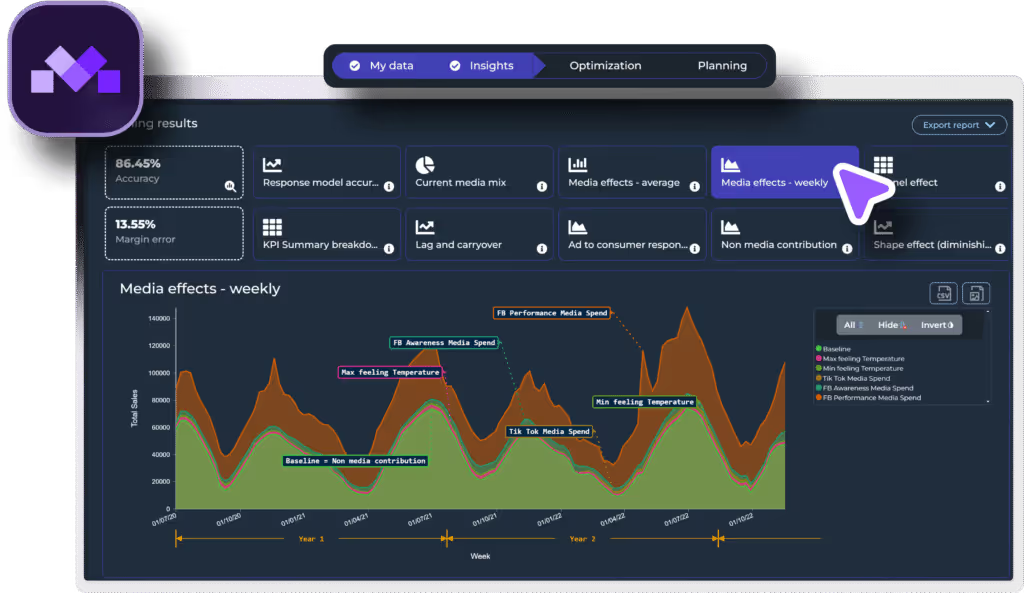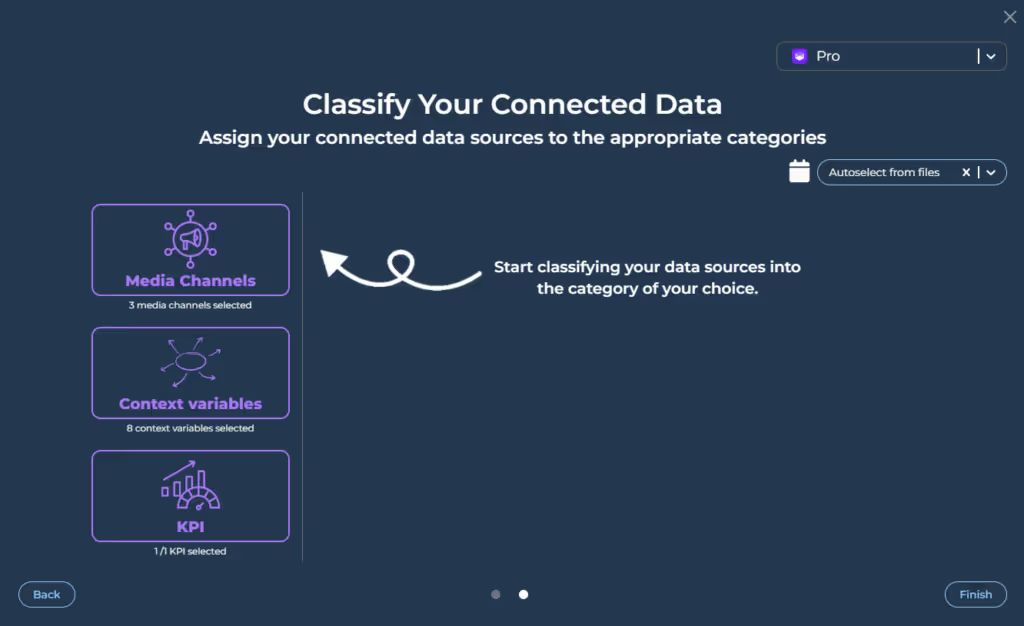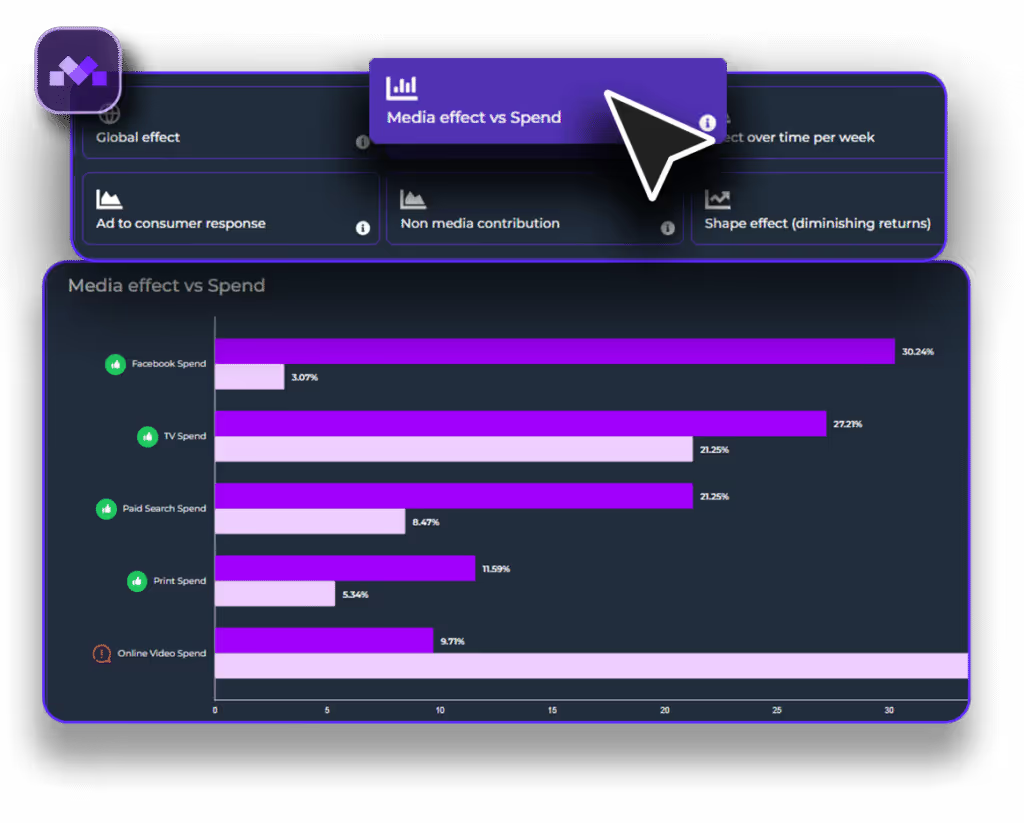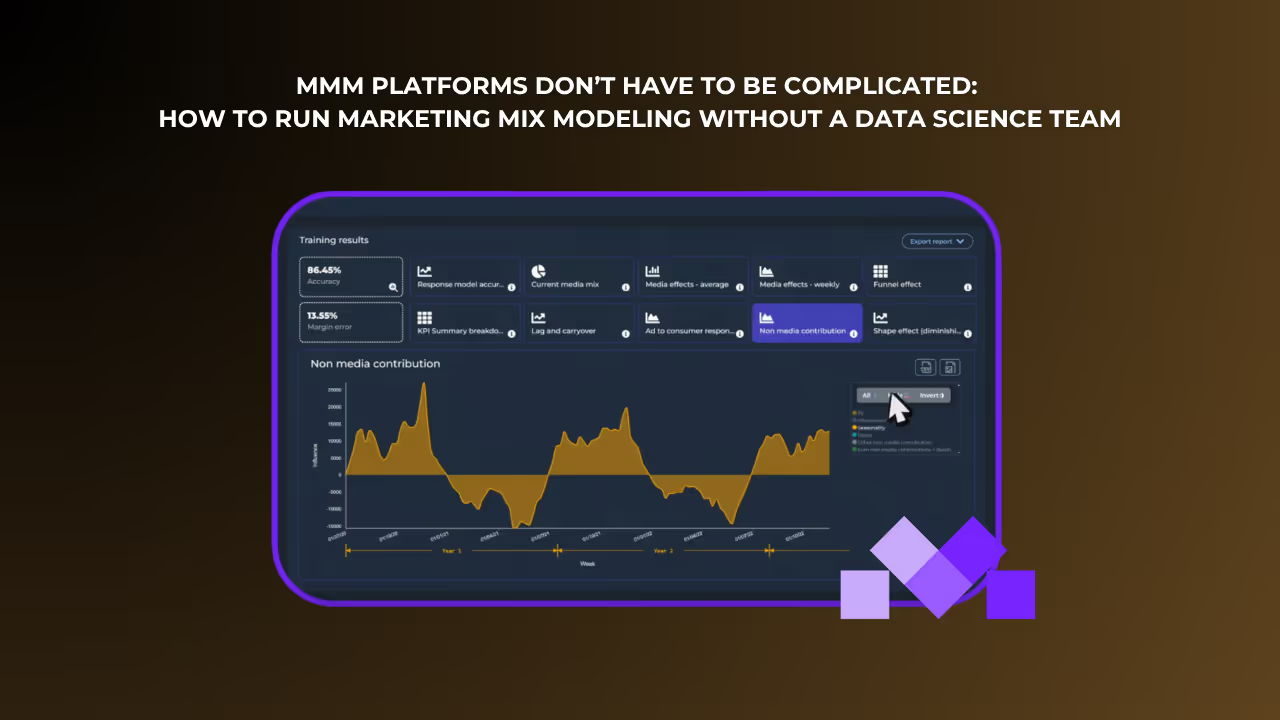Marketing teams are under pressure to prove the impact of every dollar they spend. But when results are spread across channels, search, social, TV, and offline, it’s hard to know what’s really working. That’s where MMM platforms come in.
Traditionally, Marketing Mix Modeling (MMM) required data scientists, custom code, and months of analysis. Today, that’s no longer true. With platforms like Morpheus, marketers can build and run MMM models on their own with no technical background required.
This article walks you through the essentials: the data you need, how to prepare it in Morpheus MMM, and how to turn the results into better budget decisions.
What is MMM, and Why Marketers Need It
Marketing Mix Modeling (MMM) is a family of statistical techniques that estimate the incremental contribution of every marketing lever (paid, owned, earned, and contextual) on a key KPI such as sales, leads, or subscriptions.
Instead of focusing on individual user click paths, MMM aggregates historical data (usually weekly) and separates the signal (the true impact of each channel) from the noise (seasonality, pricing changes, macroeconomic shifts).
The output is a percentage-based breakdown of how each channel, promotion, or external factor contributed to performance.
Why This Matters Right Now
- Fragmented measurement – Marketers juggle online, offline, and hybrid channels; stitched-together reports rarely provide a clear picture of what actually worked.
- Cookie loss & privacy rules – Browsers and regulations are stripping out the data needed for multi-touch attribution. MMM uses aggregated data, so it remains robust and fully compliant with no third-party cookies required.
- Budget scrutiny – CMOs and CFOs now demand clear links between spend and revenue. MMM provides hard evidence in numbers, not just anecdotes.
How Today’s MMM Platforms Solve the Data Science Gap
Classic MMM used to mean hiring econometricians, renting servers, and waiting months for a PowerPoint deck. Modern MMM platforms eliminate that workload:
Morpheus MMM is built for marketers who don’t have (or don’t want) a data science team. The platform offers:
- No-code workflow – With direct data connectors and a one-click model training process, no Python, R, or SQL is required.
- Fast turnaround – Typical datasets (2–3 years of weekly data) are processed in minutes, and actionable insights are available as soon as the model is running.
- Actionable outputs – Channel contribution charts, ROI curves, and budget recommendations are built directly into the UI.
Key Outcomes You Can Expect
- Holistic channel visibility – See online, offline, and contextual drivers side by side, all in one model.
- Scenario forecasting – Simulate "what if" scenarios, like shifting €50k from paid search to CTV, before spending a cent.
- Objective budget reallocation – Move beyond gut feelings with statistically grounded ROI curves and optimization recommendations.
- Compliance by design – Because MMM uses aggregated data, there are no personal identifiers, making it fully GDPR-compliant.
MMM platforms like Morpheus MMM remove the technical roadblocks, letting marketers focus on decisions instead of data wrangling.
With the heavy analytics handled for you, answering the board’s classic question: “How much should we spend next quarter, and where?”, becomes a five-minute exercise, not a six-week project.
What Data Does MMM Need?
For any MMM platform to deliver reliable insights, the input data must be structured, consistent, and relevant to your chosen KPI.
The goal of Marketing Mix Modeling is to measure how each marketing activity influenced performance over time, so the model needs clean historical data that reflects both internal efforts and external conditions.

Here’s a breakdown of the core data components required to run a successful model in Morpheus MMM, or any modern MMM platform:
1. Outcome Data (Your KPI)
This is the target metric the model will try to explain. It should be recorded consistently over time, usually on a weekly basis. Examples include:
- Revenue or sales units
- Conversions or leads
- Website purchases or app installs
- Registrations or subscription sign-ups
Morpheus MMM lets you choose your KPI during model setup, and you can even test multiple ones (e.g., revenue vs. transactions) to see which gives the most actionable insights.
2. Media Spend Data by Channel
This is where MMM starts to prove its value. You’ll need historical spend per channel, ideally broken down weekly. This should include:
- Paid search (Google Ads, Bing)
- Paid social (Meta, TikTok, LinkedIn)
- Display and video (YouTube, programmatic, DV360)
- Traditional media (TV, radio, OOH, print)
- Influencer marketing or sponsorships (if budgeted separately)
Morpheus MMM allows you to connect directly to media platforms or import data via CSV files. While the platform streamlines data ingestion, it works best when spend is broken down by channel, such as paid search, paid social, TV, or influencers, whether through direct integrations or manual uploads.
Preparing this structure upfront ensures greater model accuracy and clearer insights.
3. Contextual and Control Variables (Optional but Valuable)
These aren’t media investments, but they help explain performance swings. While not strictly required, including them helps the model distinguish between marketing-driven and environment-driven impact. Examples include:
- Public holidays
- Weather campaigns or seasonality
- Pricing changes or discounts
- Product launches
- Economic indicators (e.g., CPI, unemployment rates, consumer sentiment)
In Morpheus MMM, many of these factors are automatically captured by the model, so there’s no need to manually import them. Other contextual data can be uploaded as custom columns or selected from built-in libraries (such as holiday calendars or weather data in supported regions).
Why Data Structure Matters
MMM is not just a correlation tool, it relies on time-series modeling. If your data is inconsistent, contains gaps, or isn’t properly aligned across sources, the model’s accuracy will suffer.
That’s why MMM platforms like Morpheus MMM are designed to automatically align and validate your data by:
- Ensuring consistent time granularity across all inputs
- Detecting outliers and missing values
- Classifying inputs into the correct types (media, context, KPI)
Clean, structured data is the foundation of reliable insights, and platforms like Morpheus take care of much of that work for you.
Summary
To get started with Morpheus MMM, all you need is:
- 2–3 years of weekly KPI data
- Corresponding weekly media spend per channel
- Optional context variables to improve model quality
Once the data is in place, the platform takes care of the rest, making MMM accessible even if you’ve never touched a spreadsheet model or run a statistical analysis.
Clean, structured inputs are the key that allows MMM platforms to turn your raw historical data into actionable marketing insights.
How to Prepare Your Data in Morpheus MMM
One of the biggest advantages of modern MMM platforms like Morpheus MMM is how they simplify the traditionally complex process of preparing data for modeling.
What used to require teams of data scientists and weeks of manual formatting can now be done in a matter of minutes without writing a single line of code.

Whether you're working with years of historical data or just starting to collect it, Morpheus MMM is designed to make onboarding intuitive and fast.
Here’s how the platform handles data preparation, step by step, so you can focus on marketing decisions, not data wrangling.
a) Automated Data Upload
The first step in Morpheus MMM is uploading your historical data, and the platform offers multiple flexible options to do this:
- Connect directly to your marketing platforms – such as Google Ads, Meta (Facebook/Instagram), LinkedIn, and YouTube.
- Upload manually – if you're working with exports from media agencies, internal teams, or legacy systems.
Once imported, you’ll be prompted to classify your data into three essential categories:
- Media Channels – e.g., Paid Search, Display, TV
- KPI (Key Performance Indicator) – your main business goal, such as revenue or leads
- Context Variables – external factors such as holidays, discounts, or product launches
The model in Morpheus MMM is trained using a single KPI. This KPI should be a consolidated, top-level metric (e.g., total sales or total leads), not channel-level metrics.
For example: If you're measuring sales, the input should reflect total sales from all sources, not broken down by channel. This ensures the model can correctly attribute impact across media channels and avoid double-counting.
b) Validate & Clean Data
Since MMM relies on time-series modeling, having a consistent structure across all data sources is critical. Morpheus MMM automatically aligns all data to a weekly granularity, which strikes a balance between accuracy and data stability.
From the Index or My Data view in the platform, you can:
- Verify that all data series are time-synchronized
- Identify and address missing values or outliers
- Check that each variable is correctly structured and categorized
This built-in validation process helps you avoid modeling errors and ensures that the resulting insights are statistically reliable and ready for confident decision-making.
c) Optional Fine-Tuning
For advanced users or analysts, Morpheus MMM offers optional configuration settings to fine-tune the model:
- Train-test split – Set a time-based split to evaluate model performance on unseen data
- Hyperparameters – Adjust settings such as
saturation_alpha, which controls how quickly each channel’s ROI curve flattens as spend increases
These controls are completely optional. If you don’t have a technical background, the default configuration, based on robust Bayesian models, is already optimized to deliver accurate, reliable results without manual tuning.
Why It Matters
Data preparation is one of the most common bottlenecks in traditional MMM workflows.
MMM platforms like Morpheus remove this barrier, making it possible for marketers to prepare structured, clean data on their own, without needing technical support.
By ensuring a single, unified KPI, consistent time granularity, and channel-level media spend, Morpheus MMM lays a solid foundation for accurate modeling and trustworthy measurement.
From Model to Insights
Once your data is uploaded and validated, you're ready to move into the core of what MMM platforms offer: generating insights that explain which marketing efforts truly drive business outcomes.
In Morpheus MMM, running the model is as simple as clicking a button, literally.
Train Your Model with One Click
From the Insights tab, select your desired training quality, the more time you allocate, the more iterations the model will perform, resulting in higher-quality outcomes. Then, simply click Train model.
Morpheus handles all the complex modeling behind the scenes, making it accessible to everyone regardless of technical expertise.
Under the hood, Morpheus MMM uses advanced Bayesian statistical models powered by PyMC, trained on your historical data. This approach produces not just point correlations, but credible intervals and robust probability estimates, making the results more trustworthy than black-box algorithms or single-line regressions.
Model training takes just a few minutes, depending on the size of your dataset, with no need for Python scripts or manual configuration.
What You’ll See in the Insights Dashboard
Once the model is trained, Morpheus MMM presents a clear, interactive Insights Dashboard with visual outputs designed for marketers. Key visualizations include:
- Channel Contribution Charts
See how much each marketing channel, paid or organic, online or offline, contributed to your KPI. Contributions are shown as percentages, helping you spot underperformers and top drivers at a glance. - ROI Curves per Channel
Understand how each dollar spent translates into results. These curves show both historical performance and modeled expectations, making it easier to defend your budget with data, not instinct. - Trend & Seasonality Analysis
Separate marketing impact from background patterns like seasonal shifts or long-term business trends. This helps answer key questions like: Was the Q4 spike driven by campaigns, or just holiday demand?
These insights update every time you retrain the model with new data, making Morpheus MMM a truly always-on MMM platform, not a one-time analysis tool.
Why This Step Matters
In legacy MMM workflows, insight delivery came weeks, or even months, after data collection, often too late to take meaningful action.
With modern platforms like Morpheus, you get statistically robust, decision-ready insights while campaigns are still live.
You no longer need to wait on consultants or dig through spreadsheets to figure out what’s working. Instead, you can:
- Back up your strategy with credible data
- Communicate impact clearly to stakeholders
- Quickly adjust tactics mid-quarter, with confidence

From Simulation to Strategy: Optimization and Planning
Optimization: Simulate What Could Have Happened
The Optimization feature in Morpheus MMM allows you to model potential outcomes based on its recommended media allocations.
By comparing these simulated scenarios with your actual historical performance, you can identify whether a different budget distribution might have led to better results.
This isn’t just theoretical, Morpheus uses your own historical data and the econometric model behind your MMM setup to estimate performance under alternative budget conditions.
This helps you:
- Quantify the impact of your media investments
- Identify underperforming channels
- Detect saturation points where additional spend no longer drives results
In practical terms, it allows you to confidently answer the classic “what if” question: What would have happened if we had followed the model’s recommendations?
Planning: Forecast Future Scenarios Based on Data
In the Planning section, Morpheus MMM enables you to define a future budget and time period, and then simulate optimized media allocations based on that input. The model returns:
- A proposed weekly spend by channel
- Clear visualizations of diminishing returns as spend increases
This type of scenario planning allows marketing teams to explore different budget strategies before committing. Instead of relying on last year’s allocation or arbitrary percentages, you're using the same MMM framework to project likely outcomes based on current media and market dynamics.
Many planning tools exist, but Morpheus ties them directly to your model’s results, ensuring consistency between past analysis and forward-looking strategy.
Why Morpheus is Perfect for Non-Technical Marketers
Morpheus MMM is designed to make advanced marketing modeling accessible, even if you’re not a technical expert. The output is delivered through intuitive, interactive dashboards that simplify decision-making for entire marketing teams.
You can easily export your entire model as a comprehensive PDF, complete with your data, charts, and explanations, or share dashboards directly with clients and stakeholders, no extra formatting needed.
Built for Real Users, Not Just Analysts
Even if you’ve never written a line of code or run a statistical model, you can use Morpheus with confidence. The platform walks you through the full process, from uploading raw data to running your model to building your media plan.
And if something’s unclear, like a specific concept or metric, the built-in AI chat assistant can explain it in plain terms. You can ask follow-up questions and get quick, contextual answers directly inside the platform. This makes it easier for non-technical marketers to learn and use the tool with confidence and clarity.
Why Non-Technical Teams Choose Morpheus
- No coding or statistics background required
- One seamless flow: from raw data to insights to budget planning
- Works with both digital and offline channels, with no cookies or user tracking needed
- Fast model training and planning, ready in minutes
Whether you’re running a small campaign or managing multi-channel strategies, Morpheus makes marketing modeling an everyday tool your team can actually use.
Final Summary
Morpheus enables marketers, regardless of technical background, to:
- Understand true channel performance
- Simulate and compare "what-if" scenarios
- Plan marketing spend with greater confidence
- Increase ROI without relying on spreadsheets or code
By automating data preparation, modeling, and forecasting, Morpheus puts the power of Marketing Mix Modeling into the hands of everyday marketers.
Whether you're optimizing a current campaign or planning the next quarter, Morpheus turns complex data into clear, actionable decisions.
Ready to take control of your marketing mix?
Try Morpheus today and start turning your data into smarter budgets and real results.
- Sign up for a free trial at Morpheus.
- Connect your ad and analytics platforms or upload CSVs.
- Classify your channels, KPI, and context variables.
- Train your model and explore insights, Optimization, and Planning.
- Export results, share with stakeholders, and update it regularly.







